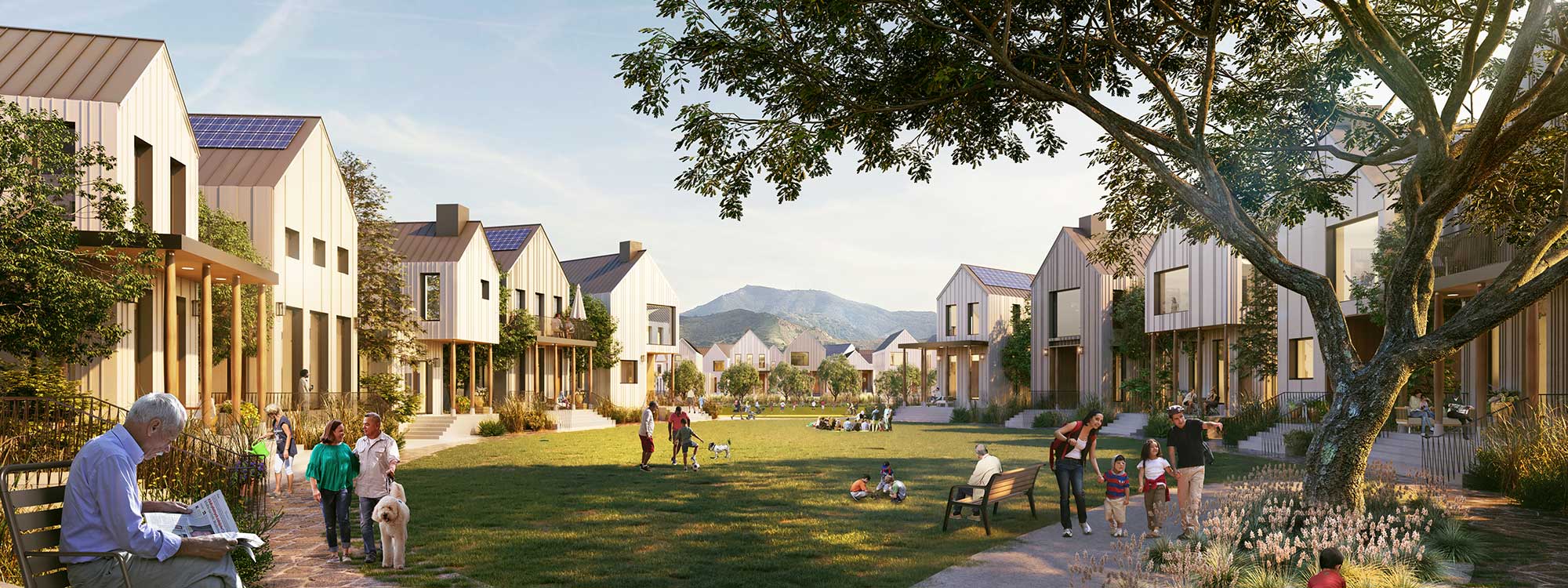Background
It is no secret that the construction of new homes has not kept up with demand in the Bay Area for many years, exacerbated by our recent economic boom, where the region added six new jobs for every new home constructed. The negative effects of this lack of housing have been even more apparent in recent months as the impacts of the coronavirus have hit our region unequally—creating even more need for homes affordable at all income levels and an increased awareness of the risks from overcrowded housing.
The State of California recently identified the need for the Bay Area to plan to accommodate close to half a million new homes over the next eight years to make a dent in our affordability crisis as part of the Regional Housing Needs Allocation (RHNA) process. This process is now at a critical juncture and we have the opportunity as a region to set a path forward that will benefit our residents and the environment for the next generation. To understand how best to do that, let’s start by shining a light on the complicated state process, RHNA.
What is RHNA?
California state law recognizes that local governments play a large role in how many homes get built in their communities, and how affordable those homes are. In 1969, the state mandated that all California cities, towns and counties must plan for the housing needs of our residents—regardless of income.
This state mandate is called the Housing Element and Regional Housing Needs Allocation, or RHNA. As part of RHNA, the California Department of Housing and Community Development, or HCD, determines the total number of new homes the Bay Area needs to build—and how affordable those homes need to be—in order to meet the housing needs of people at all income levels. This process happens every eight years.
What exactly is a Housing Element? How is it connected to a General Plan?
A Housing Element provides an analysis of a community’s housing needs for all income levels, and strategies to respond to in order to provide for those housing needs. It is a key part of the City’s overall General Plan and the one element that must be updated regularly. State Law establishes that each city must accommodate its fair share of affordable housing as an approach to distributing housing needs throughout the state.
How does each jurisdiction know how many homes they have to accommodate?
After Housing and Community Development determines the total amount of homes the region needs to accommodate, the Association of Bay Area Governments (ABAG) determines a methodology to use to allocate them. The methodology can use a variety of factors, and must be approved by HCD using various standards.
What is the ABAG RHNA HMC?
The Housing Methodology Committee (HMC) is a key part of ABAG’s approach to creating the RHNA allocation methodology. Through the HMC, ABAG’s staff seek to facilitate dialogue and information-sharing in order to enable coordinated action to address the Bay Area’s housing challenges.
The role of the HMC is to develop a draft RHNA allocation methodology for the RHNA cycle and ensure the methodology and resulting allocation meet statutory requirements. They also ensure that the methodology and resulting allocation are consistent with the forecasted development pattern included in Plan Bay Area 2050, our region’s blueprint for growth. The HMC is made up of elected officials, housing staff, and stakeholders, and Greenbelt Alliance had a seat on this year’s HMC.
Greenbelt Alliance’s Goals and Recommendations for RHNA and the Region
The RHNA process is overall focused on ensuring that there are enough affordable homes in the Bay Area, and this process is aligned with the Plan Bay Area goals of reducing greenhouse gas emissions and the federally mandated goals of affirmatively furthering fair housing to counteract the legacy of racist zoning practices. To achieve these multiple goals, ABAG staff developed a series of factor options for the HMC to consider and this data visualization tool.
Greenbelt Alliance advocates for regional growth that ensures all residents, regardless of income level, can live in healthy, climate-smart communities, close to jobs, parks, and other amenities. So when assessing the RHNA factors mentioned above, we were looking for components that increase the development of new homes at all affordability levels in the cities and towns close to job centers—reducing the long commute times that are killing our planet and our souls. This also means we looked to avoid development in our natural and working lands, which provide recreational, food production, and climate resilience benefits.
The Methodology: Advantages & Limitations
The methodology behind RHNA was created by starting with a baseline allocation that is used to assign each jurisdiction a beginning share of the RHNA. The baseline allocation is comprised of each jurisdiction’s share of the region’s total households in the year 2050 from the Plan Bay Area 2050 Blueprint. Using the 2050 Households (Blueprint) baseline takes into consideration the number of households that are currently living in a jurisdiction as well as the number of households expected to be added over the next several decades.

In assessing factors to include in the methodology, Greenbelt Alliance’s interest aligned with the majority of the committee members in ensuring cities and towns that are in climate-smart zones—in the more temperate areas surrounding the Bay and further from wildfire risk while also being close to large job centers—are accommodating more growth.
However, there are a couple of limiting factors in the methodology process. First, the factors are limited by available data. In the case of addressing climate change-related hazards, for example, we don’t have detailed enough data to tackle the nuances of how to prevent development in risky areas through this methodology process. This is frustrating! However, we do have zoning tools that we can implement in local general plans and hazard mitigation plans to reduce the risk of developing in hazard areas, and Greenbelt Alliance and our allies will continue that work along with advocacy around where we should develop.
Additionally, the Bay Area has 101 cities and nine counties, and the methodology is applied to each of these jurisdictions. It is also important to keep in mind that the region’s overall allocation is much higher than the last cycle, better reflecting the homes we actually need to build to create a thriving, sustainable region where our residents are not being crushed by an unreasonable housing burden. We are pleased that the recommended methodology centers growth not just on our biggest cities, but on the medium and smaller cities around the region, with better access to jobs, schools, and other amenities. However, given that some of our unincorporated counties are also close to job centers, the initial methodology process in some cases allocated more new homes to these counties than we consider appropriate for climate-smart growth.
Promoting Climate-Smart Growth and Reducing Sprawl
For the reasons outlined above, the methodology is a pretty blunt instrument, and while the recommended methodology addresses the goals of the process and of Greenbelt Alliance in most ways, the large allocations to unincorporated areas carry significant risk of inducing sprawl development.
Subregional methodologies: Our perspective is that overall, cities and counties should work together to ensure that county land can provide the important open space and farming benefits that we all appreciate, and cities can provide the homes, jobs, and services that we need. It is possible for a county to work with all of the cities within its boundaries to create their own RHNA methodology in a way that can address these challenges. For example, in this cycle, Napa and Solano Counties have opted for this process, giving them more flexibility to allocate homes in the areas that make the most sense for their communities. We recommend that in future cycles, more counties enter into similar agreements.
Data-based city-county adjustments: although not all counties have official subregional agreements, we’re heartened to see the cities, counties, and regional agency staff working hard to identify ways to reallocate units away from unincorporated areas, fulfilling the statutory RHNA goals of protecting environmental and agricultural resources. ABAG’s Region Planning Committee will be discussing these issues at their November 12th hearing, and after that date, you can review the meeting and minutes, and submit a comment letter by November 27th. Letters must be submitted via e-mail to RHNA@bayareametro.gov. Include “Proposed RHNA Methodology and Subregional Shares” in the subject line.
What’s Next
In order to ensure that as we grow as a region we are not increasing sprawl, greenhouse gas emissions, and commutes, all of our cities must embrace their part in building more homes. These homes are for our local workers, our children and grandchildren, and they are for new residents that come here from around the country and around the world, like many of us have, to enjoy this beautiful, vibrant, economically strong region. In the end, in many (but not all) parts of the Bay Area, it is our cities’ historic unwillingness to evolve and grow to welcome new residents that is at the heart of our ongoing housing challenge.
As advocates for protecting open space and as residents of this region, we must use our voice to speak up for more homes within our own neighborhoods, cities, and towns, just as we fight to protect our natural and working lands. Once the RHNA methodology process wraps up early next year, every community in the Bay Area will launch their Housing Element update process to identify where new homes can be built in their communities, and what changes in policy and zoning are needed to make that possible. We look forward to working together with our allies in the housing, conservation, and climate resilience communities as well as our local government leaders to advocate for Housing Elements around the region that guide the growth we need for a climate-smart future!
Photo: SOM




